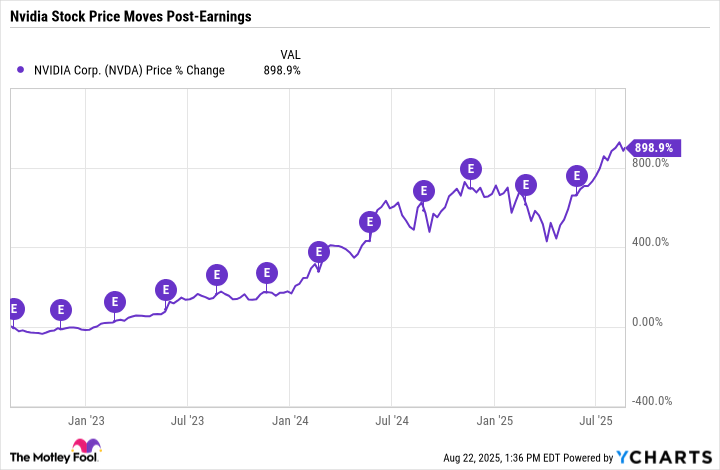The evolution of artificial intelligence (AI) over the past few years has created quite a conundrum for investors. Some fear the easy money has already been made, while others believe the adoption of AI will continue for years to come. Lest there be any doubt, I'm firmly in the second camp. Developers continue to come to terms with the potential applications of this groundbreaking technology, and the research is ongoing.
If one company represents the tug-of-war between the near limitless potential and the wall of worry surrounding AI, it would be Nvidia (NVDA 3.30%). The company pioneered the graphics processing units (GPUs) that have become the gold standard for powering generative AI applications.
As such, much is riding on Nvidia's quarterly results, particularly as the stock is within striking distance of a new all-time high. Some investors are wondering whether they should lay out their hard-earned money to buy the stock before its highly anticipated financial report on Aug. 27 or wait until the results are in.
While past performance is no guarantee of future results, a look back at Nvidia's history provides a compelling answer.

Image source: Getty Images.
Setting the stage
It has been a busy few months since Nvidia reported its most recent quarterly results.
After much lobbying by CEO Jensen Huang, the Trump administration has lifted the moratorium on Nvidia's H20 chip, with the company agreeing to pay 15% from its chip sales to China. After concerns were raised, Nvidia has provided assurances to the Chinese government that its chips contain no backdoors, no kill switches, and no spyware. Huang also confirmed recent reports that Nvidia is developing a new AI data center processor based on its Blackwell architecture for its Chinese customers.
And despite decelerating growth, Nvidia set a high bar with its most recent financial results. During its fiscal 2026 first quarter (ended April 27), Nvidia delivered record revenue of $44.1 billion, which soared 69% year over year and 12% sequentially. Excluding a one-time charge related to the moratorium on its H20 chips, adjusted earnings per share (EPS) jumped 62% to $0.96.
The company's data center segment, which includes chips used for AI, cloud computing, and data centers, was the star of the show. Revenue for the segment surged 73% to $39 billion, as AI chips continued to fly off the shelves.
Nvidia is scheduled to report its second-quarter results after the market close on Wednesday, and investors will be keeping their eyes peeled for signs that demand for AI is waning. Three months ago, management's forecast suggested these strong secular tailwinds would continue. For the second quarter, Nvidia guided for revenue of $45 billion, representing growth of about 50%.
Should you buy before Aug. 27?
The chart below illustrates Nvidia's stock price movements over the past three years. The purple circles denoted by the letter E mark when the company released its financial reports. In all but three of these instances, or 75% of the time, the stock climbed in the wake of Nvidia's earnings report, fueled by investors piling into the stock.
What sparked most of these moves higher was the combination of better-than-expected results and management raising its forecast. Management's strong track record suggests that Nvidia is well positioned to continue its history of "beat and raise."
Data by YCharts.
It's important to give this some context. Investor sentiment isn't reliable, but it tends to drive stock price moves higher and lower. There's no way to know for sure how investors will take the results on a given day, so I don't generally recommend date-driven stock buying.
That said, history shows that Nvidia tends to move higher in the days and weeks following its financial report.

NASDAQ: NVDA
Key Data Points
Wall Street is bullish on Nvidia
Wall Street rarely agrees on anything, so it's worth mentioning that a majority of analysts who cover Nvidia believe the stock has further to climb. Of the 65 analysts who offered an opinion (thus far) in August, a whopping 89% have a buy or strong buy rating on the stock, and only one recommends selling.
Loop Capital analyst John Donovan recently became Nvidia's biggest cheerleader, maintaining a buy rating with a Street-high price target of $250. This represents potential upside of 43% compared to the stock's closing price on Thursday. The analyst cites channel checks with cloud providers and other large-scale chip buyers in suggesting that Wall Street continues to underestimate the demand for AI-centric processors.
One final item of note. Nvidia stock is currently selling for 30 times next year's earnings. While that's certainly a premium, the company's track record and the secular tailwinds of AI suggest the stock still has room to run -- though it will inevitably experience some turbulence along the way.





